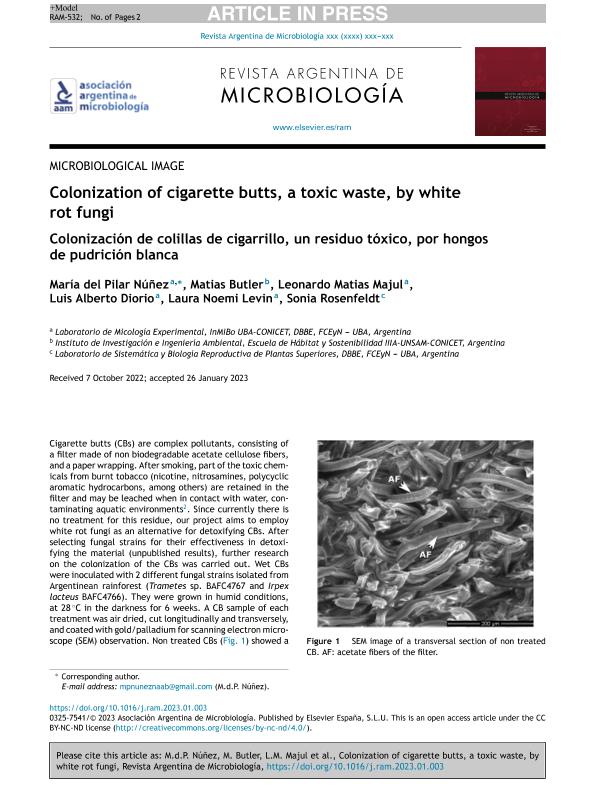Artículo
Colonization of cigarette butts, a toxic waste, by white rot fungi
Título:
Colonización de colillas de cigarrillo, un residuo tóxico, por hongos de pudrición blanca
Núñez, María del Pilar ; Butler, Matias
; Butler, Matias ; Majul, Leonardo Matias
; Majul, Leonardo Matias ; Diorio, Luis Alberto; Levin, Laura Noemí
; Diorio, Luis Alberto; Levin, Laura Noemí ; Rosenfeldt, Sonia
; Rosenfeldt, Sonia
 ; Butler, Matias
; Butler, Matias ; Majul, Leonardo Matias
; Majul, Leonardo Matias ; Diorio, Luis Alberto; Levin, Laura Noemí
; Diorio, Luis Alberto; Levin, Laura Noemí ; Rosenfeldt, Sonia
; Rosenfeldt, Sonia
Fecha de publicación:
21/03/2023
Editorial:
Asociación Argentina de Microbiología
Revista:
Revista Argentina de Microbiología
ISSN:
1851-7617
Idioma:
Inglés
Tipo de recurso:
Artículo publicado
Clasificación temática:
Resumen
Cigarette butts (CBs) are complex pollutants, consisting of a filter made of non biodegradable acetate cellulose fibers, and a paper wrapping. After smoking, part of the toxic chemicals from burnt tobacco (nicotine, nitrosamines, polycyclic aromatic hydrocarbons, among others) are retained in the filter and may be leached when in contact with water, contaminating aquatic environments2. Since currently there is no treatment for this residue, our project aims to employ white rot fungi as an alternative for detoxifying CBs. After selecting fungal strains for their effectiveness in detoxifying the material (unpublished results), further research on the colonization of the CBs was carried out. Wet CBs were inoculated with 2 different fungal strains isolated from Argentinean rainforest (Trametes sp. BAFC4767 and Irpex lacteus BAFC4766). They were grown in humid conditions, at 28 °C in the darkness for 6 weeks. A CB sample of each treatment was air dried, cut longitudinally and transversely, and coated with gold/palladium for scanning electron microscope (SEM) observation. Non treated CBs (Fig. 1) showed a more compact fiber structure than the treated ones. Fungal growth both on the outside and the inside of the CBs was observed for all treatments (Figure 2, Figure 3). Most of the mycelium developed around the paper wrapper (PW), which displayed signs of deterioration and is supposed to be the fungus food source. It was noteworthy to observe such a degree of fungal invasion on the inside of the CBs, since this part is where most of the toxic chemicals are concentrated. These results support the detoxifying capacity observed for the selected fungi. White rot fungi are known for their ability to degrade and detoxify xenobiotics such as phenolic compounds and aromatic hydrocarbons1. To the best of our knowledge, this is the first visual report of CBs fungal colonization.
Archivos asociados
Licencia
Identificadores
Colecciones
Articulos (IIIA)
Articulos de INSTITUTO DE INVESTIGACION E INGENIERIA AMBIENTAL
Articulos de INSTITUTO DE INVESTIGACION E INGENIERIA AMBIENTAL
Articulos(INMIBO (EX - PROPLAME))
Articulos de INSTITUTO DE MICOLOGIA Y BOTANICA
Articulos de INSTITUTO DE MICOLOGIA Y BOTANICA
Citación
Núñez, María del Pilar; Butler, Matias; Majul, Leonardo Matias; Diorio, Luis Alberto; Levin, Laura Noemí; et al.; Colonization of cigarette butts, a toxic waste, by white rot fungi; Asociación Argentina de Microbiología; Revista Argentina de Microbiología; 55; 3; 21-3-2023; 289-290
Compartir
Altmétricas



